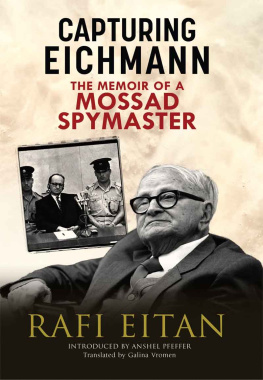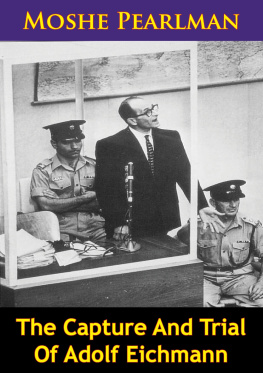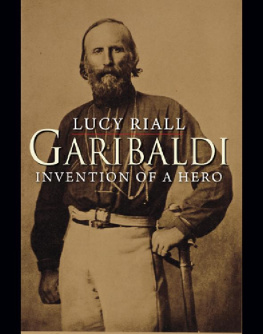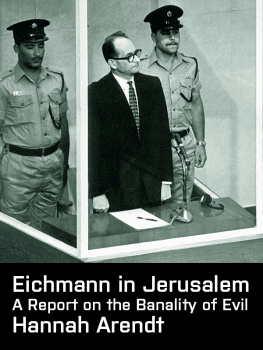Eichmann Adolf - The House on Garibaldi Street
Here you can read online Eichmann Adolf - The House on Garibaldi Street full text of the book (entire story) in english for free. Download pdf and epub, get meaning, cover and reviews about this ebook. City: Israel;Germany, year: 2013, publisher: Taylor and Francis;Routledge, genre: Detective and thriller. Description of the work, (preface) as well as reviews are available. Best literature library LitArk.com created for fans of good reading and offers a wide selection of genres:
Romance novel
Science fiction
Adventure
Detective
Science
History
Home and family
Prose
Art
Politics
Computer
Non-fiction
Religion
Business
Children
Humor
Choose a favorite category and find really read worthwhile books. Enjoy immersion in the world of imagination, feel the emotions of the characters or learn something new for yourself, make an fascinating discovery.

- Book:The House on Garibaldi Street
- Author:
- Publisher:Taylor and Francis;Routledge
- Genre:
- Year:2013
- City:Israel;Germany
- Rating:4 / 5
- Favourites:Add to favourites
- Your mark:
- 80
- 1
- 2
- 3
- 4
- 5
The House on Garibaldi Street: summary, description and annotation
We offer to read an annotation, description, summary or preface (depends on what the author of the book "The House on Garibaldi Street" wrote himself). If you haven't found the necessary information about the book — write in the comments, we will try to find it.
The House on Garibaldi Street — read online for free the complete book (whole text) full work
Below is the text of the book, divided by pages. System saving the place of the last page read, allows you to conveniently read the book "The House on Garibaldi Street" online for free, without having to search again every time where you left off. Put a bookmark, and you can go to the page where you finished reading at any time.
Font size:
Interval:
Bookmark:
THE HOUSE ON GARIBALDI STREET
CLASSICS OF ESPIONAGE
General Editor: Wesley K. Wark
Other titles in the Series
Spies of the Kaiser by William Le Queux
Introduction by Nicholas Hiley
British Agent by John Whitwell
Introduction by Wesley K. Wark
The Serpent Sleeping by Edward Weismiller
Introduction by Tim Naftali
The Dark Invader by Captain Franz von Rintelen
Introduction by Reinhard Doerries
ISSER HAREL
THE HOUSE ON GARIBALDI STREET
Edited and with an introduction by
SHLOMO J. SHPIRO

First published 1975 by The Viking Press, Inc.
Published 1997 by Frank Cass Publishers
Published 2013 by Routledge
2 Park Square, Milton Park, Abingdon, Oxon OX14 4RN
711 Third Avenue, New York, NY, 10017, USA
Routledge is an imprint of the Taylor & Francis Group, an informa business
Copyright 1997 Frank Cass and Co Ltd.
Introduction Copyright 1997 Shlomo J. Shpiro
All rights reserved. No part of this book may be reprinted or reproduced or utilised in any form or by any electronic, mechanical, or other means, now known or hereafter invented, including photocopying and recording, or in any information storage or retrieval system, without permission in writing from the publishers.
British Library Catloguing in Publication Data
Harel, Isser
The house on Garibaldi Street. - 2nd ed. - (Classics of espionage)
1. Eichmann, Adolf, 19061962 - Kidnapping 2. Eichmann, Adolf, 19061962 - Trials, litigation, etc. 3. Trials (Genocide) - Israel 4. Secret Service Israel 5. Espionage, Israel Argentina 6. War criminals Germany I. Title
364.151092
Library of Congress Cataloging-in-Publication Data
Harel, Isser, 1912
The house on Garibaldi Street / Isser Harel; with an introduction by Shlomo J. Shpiro. [New ed.]
p. cm. (Classics of espionage)
ISBN 0714647543 (cloth). ISBN 0714643157 (pbk.)
1. Eichmann, Adolf, 19061962. 2. War criminalsGermanyBiography. 3. Secret serviceIsrael. 4. Harel, Isser, 19125. Israel. Mosad le-modi in e-tafidim meyuadimBiography.
I. Title. II. Series.
DD247.E5H27 1997
| 364.15T092dc21 | 9650134 |
ISBN 13: 978-0-714-64315-1 (pbk)
ISBN 13: 978-0-714-64754-8 (hbk)
CONTENTS
Shlomo J. Shpiro
T HE PUBLIC trial in Israel of Adolf Eichmann, the man who directed the Third Reichs Final Solution, was held in 1961 under an unprecedented publicity coverage. The trial, which took place in Jerusalem, attracted hundreds of reporters and media crews from all over the world. For the first time since the end of the Second World War the horrific crimes of the Nazi regime against the Jewish people were exposed in all their brutality by one of their leading perpetrators. Eichmann stood at the top of the Gestapo pyramid dedicated to the destruction of Europes Jewry, and was personally responsible not only for policy decisions but for the everyday running of this unparalleled genocide. His trial and subsequent execution brought to millions of homes around the world the untold story of the Holocaust from its chief administrator. The Eichmann trial had a profound influence in particular on the young generation of Israeli citizens, born after the end of the Second World War. This generation, born into a country which had built itself as a national home for the Jewish people in order to prevent such persecution in the future, swore as it joined the army never again to let Jewish people be led to their death unresisting.
But this well-publicised trial was preceded by a top secret operation conducted by Israels foreign intelligence service - the Mossad. The Mossad carried out one of this centurys most audacious intelligence coups. Its undercover team, operating without official cover half-way across the globe from their base in Tel-Aviv, located Eichmann in Argentina, kidnapped and smuggled him to Israel to be handed over to the judicial authorities.
The success of this complex intelligence operation depended not only on planning and professionalism but also on flexibility and improvisation in order to resolve numerous problems encountered during the mission. The Mossad team was led by Isser Harel, Israels Memune - the top intelligence official in charge of the Mossad and its counterpart the Shabak the internal security service. Harels presence on the ground throughout the operation enabled crucial decisions to be taken immediately without referring to higher authority. Harels leadership was critical to the success of the mission and to Eichmanns being brought to justice. The House on Garibaldi Street is Harels personal and authoritative account of the Eichmann capture. Like many intelligence memoirs, while exciting on the details of operations, it reveals little of the man or his career.
Isser Harel commanded both of Israels civilian intelligence organisations for over 12 years. More than anyone else he was responsible for transforming Israels fledgling intelligence services from a loose grouping of pre-independence underground organisations in 1948 to a community of formidable, professional and capable services. He was the only man in Israels history to hold the top position in both the internal and external intelligence organisations, and after his retirement in 1963 these jobs were separated and assigned to different people. Harels dedication to Israels security, his organisational capabilities and his relations with Israels leading politicians enabled him to develop the Mossad and carry out seemingly impossible missions. The achievements of the Mossad under Harel contributed greatly to Israels security and its political and military successes.
Isser Harel was born Isser Halperin in Vitebsk, a small town in White Russia, in 1912.he met his future wife, Rivka. The couple got married and in 1935 left the kibbutz and settled in Herzliya. Isser joined the Hagana, a clandestine Jewish organisation founded to be the military arm of the Jewish community in Palestine. It was in the Hagana that his talents for intelligence work were spotted. Harel was employed in special duties involving undercover work and later assigned to work in the Shai the Haganas intelligence branch.
The Shai comprised a small group of dedicated but amateur operatives, working out of one flat in Tel-Aviv. It was the nucleus of Israels future intelligence services. The Shai developed the first intelligence systems and doctrines for covert work in the Arab countries, and spied not only on Arab parties and militant groups but on the British mandate authorities as well. Harel introduced to the work of Shai the elements of standardisation, thoroughness and professionalism. He organised its registry, collected reports and initiated its system of intelligence analysis. As a capable organiser he managed to obtain funds, facilities and personnel to expand the Shais collection capabilities as threats to the security of the Jewish community in Palestine grew. The information collected by Shai was used by the Hagana to mount operations against British bases and Arab bands. Harels collection efforts were not limited to Arabs and British targets, but expanded to cover Jewish extremist organisations and later also the activities of the Soviets in Palestine.
In his work at Shai Harel made contacts with leading politicians and, most important of all, with David Ben-Gurion, Israels elder statesman. It was the beginning of a life-long relationship which would lead both men to the peak of their careers, but also to bitter conflicts and differences of opinion. Ben-Gurion took a liking to the energetic young man and assigned him to more and more duties. When the state of Israel gained independence in 1948 it was only natural that Harel was called to take his place as the head of the newly founded Shabak the internal security service.
Next pageFont size:
Interval:
Bookmark:
Similar books «The House on Garibaldi Street»
Look at similar books to The House on Garibaldi Street. We have selected literature similar in name and meaning in the hope of providing readers with more options to find new, interesting, not yet read works.
Discussion, reviews of the book The House on Garibaldi Street and just readers' own opinions. Leave your comments, write what you think about the work, its meaning or the main characters. Specify what exactly you liked and what you didn't like, and why you think so.








